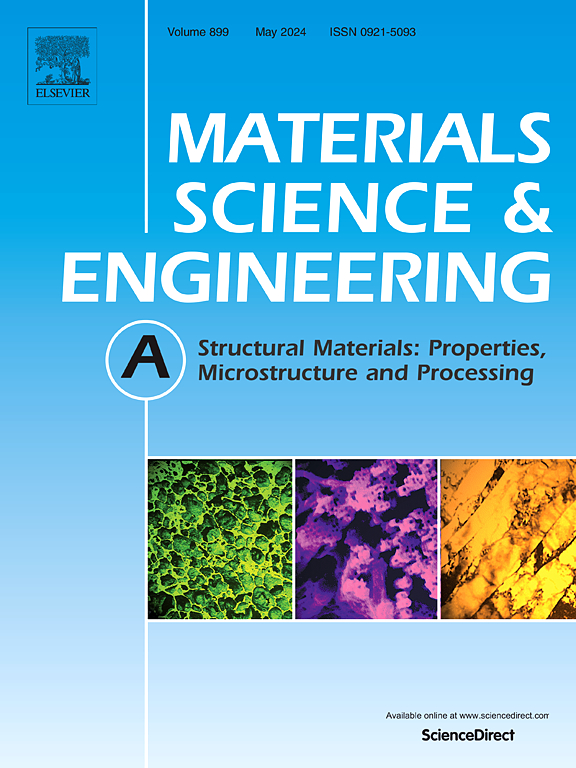晶粒尺寸对具有超高强度和应变硬化率的代谢型 β-Ti 合金中应力诱导马氏体的影响
IF 6.1
2区 材料科学
Q1 MATERIALS SCIENCE, MULTIDISCIPLINARY
引用次数: 0
摘要
在本研究中,我们研究了在一种可变质的 β-Ti 合金(Ti-4Mo-3Cr-1Fe-1Al)中,β 晶粒大小对应力诱发马氏体(SIM)的影响。通过冷轧和退火制备了不同晶粒大小的样品。随着晶粒尺寸从 44 μm 增加到 180 μm,SIM 的触发应力降低。同时,屈服强度随着晶粒尺寸的减小而增加,这与霍尔-佩奇效应一致。与粗晶粒样品相比,细晶粒样品在变形过程中形成了更多的马氏体带,从而产生了高达 4320 MPa 的超高应变硬化率。Ti-4Mo-3Cr-1Fe-1Al合金的变形机制包括ω到β的转变、SIM、马氏体变形孪晶({110}cc<1-10>α "和{130}<-310>α "孪晶)、马氏体的重新取向和位错滑移。44 μm 和 59 μm 样品都显示出超高的真实抗拉强度(1200 兆帕),相对于屈服强度,加工硬化区间大,接近 600 兆帕。这种显著的加工硬化能力归因于变形过程中动态形成的马氏体带所产生的界面强化和位错强化。本文章由计算机程序翻译,如有差异,请以英文原文为准。
Grain size effect on stress-induced martensite in a metastable β-Ti alloy with ultrahigh strength and strain hardening rate
In the present work, the influence of β grain size on stress-induced martensite (SIM) was investigated in a metastable β-Ti alloy (Ti-4Mo-3Cr-1Fe-1Al). Samples with varying grain sizes were prepared by cold rolling and annealing. The triggering stress for SIM decreases with the grain size increase from 44 μm to 180 μm. Meanwhile, the yield strength increases with decreasing grain size, consistent with the Hall-Petch effect. Fine-grained samples formed a greater number of martensitic bands during deformation compared to coarse-grained samples, resulting in an ultra-high strain-hardening rate ∼4320 MPa. The deformation mechanism of the Ti-4Mo-3Cr-1Fe-1Al alloy consists of the ω to β transformation, SIM, martensite deformation twinning ({110}cc < 1–10>α" and {130}<-310>α" twins), reorientation of martensite and dislocation slip. Both the 44 μm and 59 μm samples exhibit ultra-high true tensile strengths (>1200 MPa), with a large work-hardening interval of nearly 600 MPa relative to the yield strength. This significant work-hardening capability is attributed to interfacial and dislocation strengthening arising from the dynamic formation of martensitic bands during deformation.
求助全文
通过发布文献求助,成功后即可免费获取论文全文。
去求助
来源期刊

Materials Science and Engineering: A
工程技术-材料科学:综合
CiteScore
11.50
自引率
15.60%
发文量
1811
审稿时长
31 days
期刊介绍:
Materials Science and Engineering A provides an international medium for the publication of theoretical and experimental studies related to the load-bearing capacity of materials as influenced by their basic properties, processing history, microstructure and operating environment. Appropriate submissions to Materials Science and Engineering A should include scientific and/or engineering factors which affect the microstructure - strength relationships of materials and report the changes to mechanical behavior.
 求助内容:
求助内容: 应助结果提醒方式:
应助结果提醒方式:


